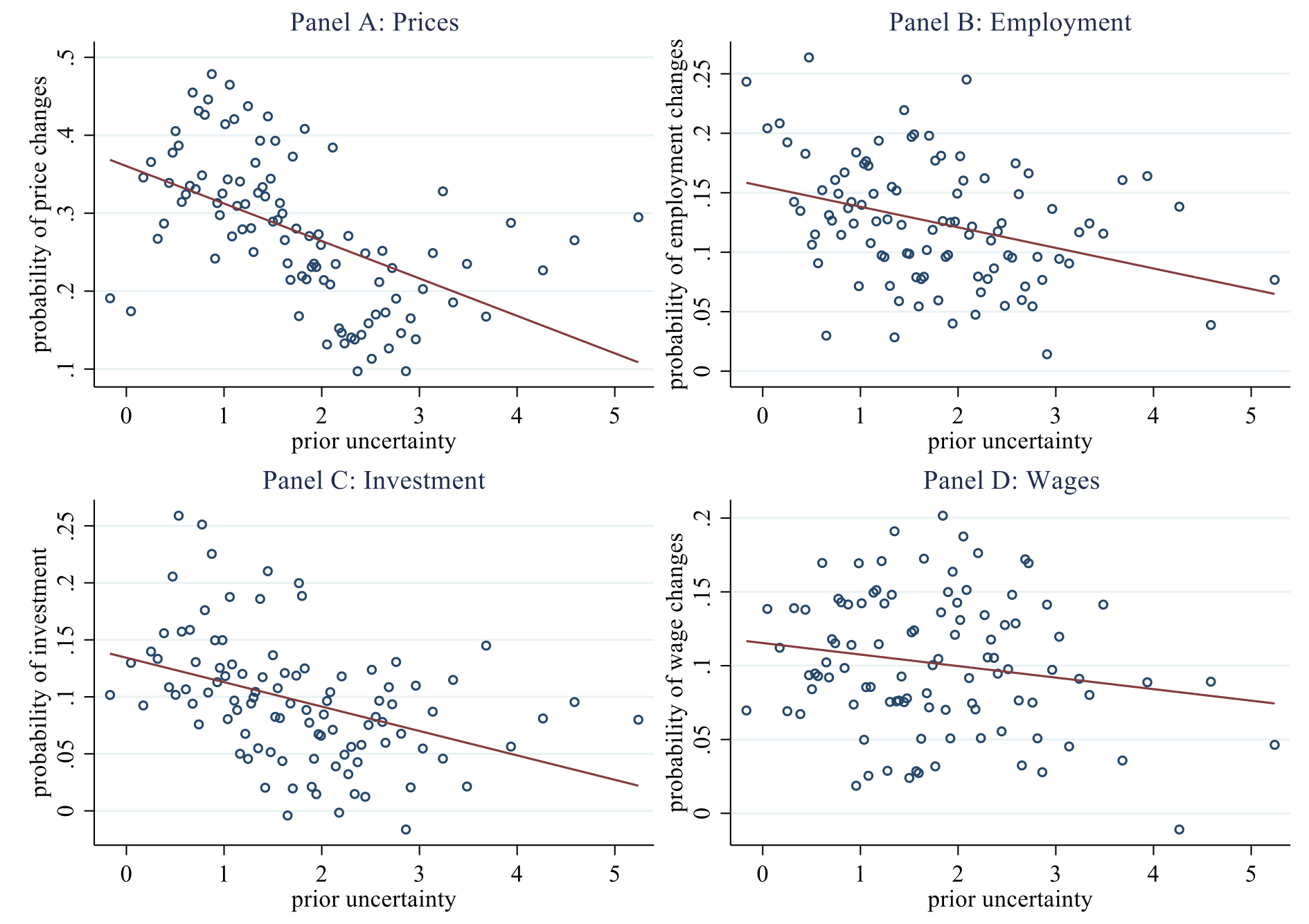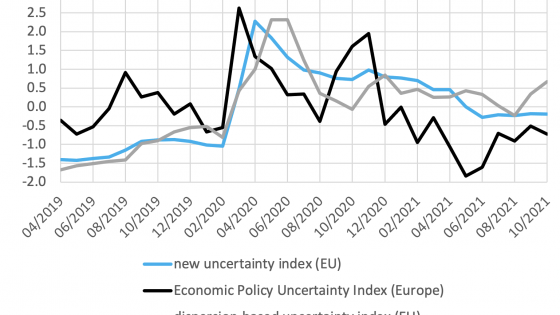The source of business cycle fluctuations has long stymied macroeconomists. One of the most promising recent ideas emanated from Bloom (2009), when he proposed that uncertainty, a second moment, could be a candidate explanation for business cycles. Unlike most of the competing explanations, the uncertainty hypothesis could identify specific recognisable episodes (e.g. Black Monday) as ‘shocks’ that seemed a priori exogenous to the aggregate economy. But as emphasised in Bloom (2014), the very high correlation between first and second moments in beliefs makes the identification of exogenous changes in uncertainty using standard time-series timing restrictions a difficult challenge. As a result, it has been difficult to establish the role that uncertainty actually plays in affecting the economic decisions of households and firms. In a new paper (Kumar et al. (2022), we tackle this issue directly by implementing a randomised control trial (RCT) with firms in New Zealand. The RCT created exogenous changes in firms’ macroeconomic uncertainty which allows us to assess how this uncertainty, net of first moments, affected the actual decisions of firms. We find that uncertainty affects firms’ decisions along a number of different margins, thereby providing some of the clearest causal evidence showing that uncertainty is a significant force in firms’ decision-making.
Why an RCT?
If a firm is very uncertain about the future, they have an incentive to postpone committing to investment or hiring decisions that may be difficult to reverse. Instead, they can choose to simply wait out the uncertainty and make decisions after the uncertainty is resolved. This precautionary mechanism implies that increases in uncertainty can readily generate economic slowdowns. And empirical evidence is often consistent with such effects. For example, among New Zealand firms, we find that those firms who are more uncertain about the future macroeconomic outlook in terms of GDP growth are more likely to report that they expect not to change prices, employment, investment, and wages in coming months, as shown in Figure 1 below.
Figure 1 Uncertainty and bands of inaction
Notes: Each panel plots binscatters of firms’ macroeconomic uncertainty (x-axis) versus the fraction of firms in each bin reporting that they expect to change prices (Panel A), employment (Panel B), investment (Panel C) or wages (panel D) over the next 6 months after orthogonalising with respect to firm demographics and their expectations for the level of GDP growth. Source: Kumar et al. (2022).
While one may want to infer causality from such evidence, other factors could explain this type of correlation. For example, firms which are more uncertain may report higher uncertainty because they place a higher weight on a possible future downturn than other firms. These firms would therefore tend to have lower expected growth rates for the economy (first moments) and higher uncertainty (second moments) than others. Because of this tight correlation between first and second moments, it would therefore be difficult to determine whether decisions were determined by the first or the second moments.
To address this fundamental issue, we apply an RCT strategy to generate exogenous variation in both first and second moments. Specifically, in a survey of firms in New Zealand, randomly selected groups of firms were provided with different pieces of information about the aggregate economic outlook (or no information at all). These different information treatments, which include either average GDP forecasts of professional forecasters and/or the difference between optimistic and pessimistic forecasts of professionals, lead to different and often large relative changes in firms’ first and second moment expectations about future aggregate growth, thereby providing a powerful way to quantify the effects of uncertainty (net of first moments) on firms’ decisions.
Uncertainty and firm decisions
To assess how firm decisions are affected by uncertainty, we implemented two different survey waves. The first wave, run between June and August 2021, focused on measuring what firms were planning to do over the next six months in terms of employment, investment, wages, and prices among others, measuring their aggregate expectations, and implementing the information treatment. The second survey, run six months later between November 2021 and January 2022, then asked the same firms to report what actions they had taken over the previous six months in terms of the variables as measured in the first wave, as well as some additional dimensions. It also measured their macroeconomic and microeconomic expectations again. Jointly, these survey waves provide us with a clear set of outcome variables that can be used to determine which channels matter in terms of how firms respond to changes in uncertainty.
This strategy allows us to present clear causal evidence that exogenous changes in uncertainty affect firms’ economic choices. Higher macroeconomic uncertainty on the part of firms leads them to reduce their prices, employment, and investment over the next six months relative to their prior plans. We argue in the paper that these effects are large in an economic sense. Firms experience a decline in sales but increase their advertising. They report that information about the aggregate economy becomes more valuable to them, both in absolute terms as well as relative to information about their industry. We also find that firms with higher uncertainty are less likely to invest in new technologies or develop new facilities. The effect on wages, however, is effectively zero and we cannot reject the null that higher uncertainty does not make firms less likely to develop new products.
These results are also broadly in line with how firms report they would respond to a hypothetical change in their uncertainty. On average, firms report that higher uncertainty would tend to make them more likely to lower prices, employment, and investment, and experience lower sales, but increase their advertising, consistent with the results of the RCT. They also report that they would be less likely to invest in new technologies or develop new facilities, again consistent with the RCT. A smaller fraction report that they would reduce wages and be less likely to develop new products, results which we could not statistically confirm or reject in the RCT. The hypothetical questions also address margins not considered in the RCT. For example, firms in New Zealand report that higher uncertainty would make them less likely to seek out new export markets (we do not have enough variation along this margin in our survey to quantify it), as well as less likely to seek out new loans but more likely to hold cash, precautionary financial mechanisms that we did not otherwise ask firms about for the RCT due to space constraints.
Implications
Jointly, these results provide new evidence on how uncertainty affects firm decisions. But what do they mean about the specific types of uncertainty that matter? Previous work measuring uncertainty at the firm level has focused primarily on microeconomic uncertainty, e.g. uncertainty about future sales growth of the firm. Our survey measures both micro and macro uncertainty, and as one might expect they are generally quite strongly correlated. However, our information treatments lead to large changes in firms’ macroeconomic uncertainty but only small changes in microeconomic uncertainty. Furthermore, when we control for these changes in firms’ beliefs about their own future sales, both in terms of means and uncertainty, our results on the effects of macroeconomic uncertainty on firms’ decisions are unchanged. This indicates that firms’ perceptions about the future macroeconomic outlook matter above and beyond the implications for their own future sales. We interpret this as suggesting that when measuring firm-level uncertainty, it is important to not just capture firms’ uncertainty about their outlook over their own immediate sales but also to capture uncertainty about broader economic conditions and policies, as emphasised in Baker et al. (2016) and Alfaro et al. (2021). This interpretation can also help explain why some aggregate uncertainty shocks like Brexit can have broad contractionary effects on many firms, even when they are not directly exposed to trade with the EU (Bloom et al. 2019).
While the uncertainty literature has emphasised the dangers of rising uncertainty as a possible source of downturns, the flip side is that our results suggest that policymakers could try to reduce uncertainty through communication as a way to stabilise economic activity. Our simple information treatments, which involved no more than providing firms with professional forecasts in levels and distribution, were powerful in reducing the macroeconomic uncertainty perceived by most firms, leading many of them to increase their hiring and investment. Policymakers often try to protect their credibility by being deliberately vague in their statements to try and avoid being proven wrong ex-post or having to engage in subsequent policy reversals. The downside of this approach is that it may significantly increase uncertainty among ordinary citizens. Less ambiguity by policymakers and projecting more confidence could potentially achieve the reverse.
References
Alfaro, I, N Bloom and X Lin (2021), “The Finance Uncertainty Multiplier”, Manuscript.
Baker, S R, N Bloom and S J Davis (2016), “Measuring Economic Policy Uncertainty”, Quarterly Journal of Economics 131: 1593–1636.
Bloom, N, P Bunn, S Chen, P Mizen, P Smietanka and G Thwaites (2019), “The Impact of Brexit on UK Firms”, NBER Working Paper 26218.
Bloom, N (2009), “The Impact of Uncertainty Shocks”, Econometrica 77(3): 623-685.
Bloom, N (2014), “Fluctuations in Uncertainty”, Journal of Economic Perspectives 28:153-76.
Kumar, S, Y Gorodnichenko and O Coibion (2022), “The Effect of Macroeconomic Uncertainty on Firm Decisions”, CEPR Press Discussion Paper No. 17495.







